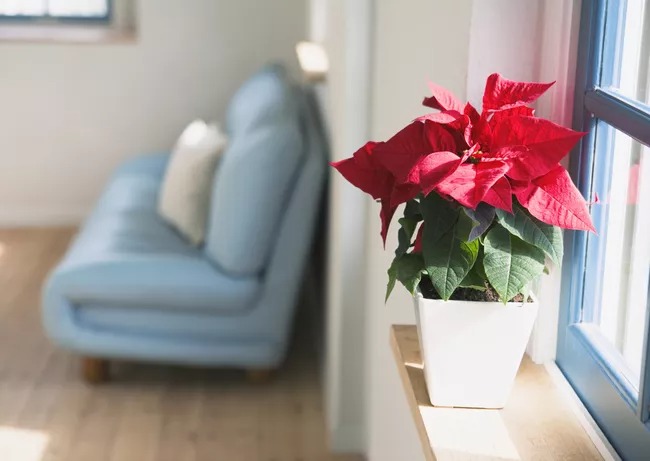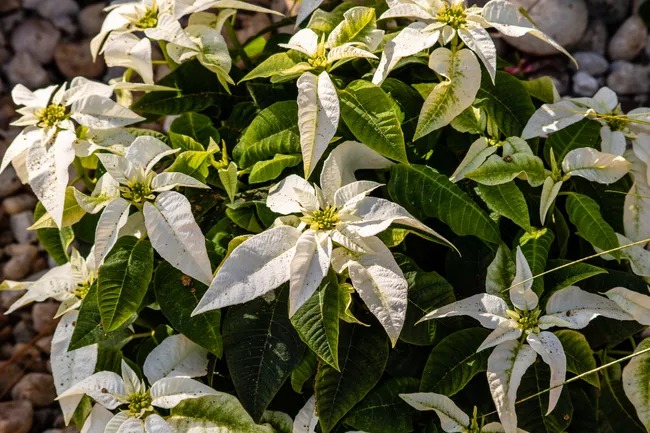There’s nothing like growing your own poinsettia plants instead of buying new ones every holiday season. While it is easier to buy these plants fully grown and at peak color, gardeners up to the challenge will enjoy the slow progress that comes with starting a plant from seed or cuttings.
| Botanical name | Euphorbia pulcherrima |
| Common name | Poinsettia |
| Sun exposure | Full sun to part shade |
| Soil type | Well-draining and loamy |
| Soil pH | Neutral to acidic |
| Bloom time | Winter |
| Flower color | Red, white, pink, yellow, purple, green, and multicolored |
| Hardiness zone | 9-11 (USDA) |
| Toxicity | Toxic to dogs and cats |
How to Plant Poinsettias
It’s best to get started with a strong poinsettia plant. However, there are some other methods you can try when growing poinsettias.
Growing From Seed
Growing from seed isn’t how most gardeners start poinsettias, but it can be a fun challenge. The bright red “flowers” are actually called bracts, and if you follow the bract down on a poinsettia plant, you’ll see the real yellow flowers, where seed pods develop. If poinsettias are in the wild, natural pollination occurs to produce seed pods. Inside as houseplants, poinsettias need your help with the pollination process.
Growing From Cutting
Start with a healthy plant, and then take a cutting at least a few inches long with a few mature leaves. Dip the end of the cutting in the rooting hormone. Then, place it in quality soil (an indoor soil mix would be good) with a pre-formed hole. Secure with soil, water it, and place it in a bright location that doesn’t get direct sun. Wait a few weeks for roots to take hold. Keep your cutting watered, but don’t overdo it. After a few weeks, give the cutting a gentle tug to see if you feel roots in place. You might also try to do a few cuttings at once in hopes that half might take root. This isn’t a guaranteed process and might take a little trial and error.
Starting or Transplanting Existing Plants
For existing poinsettias—perhaps leftover from the holidays—the process is simple. Repot them as needed. You might not need to do this at all if the plant is already in a good container where your plant has lots of room. Make sure to remove any yellow or wilted leaves. Then, keep it as a houseplant and follow our poinsettia plant care tips. The plant will also need to go through a dark, dormant period, detailed below. If you time this right, you’ll have gorgeous plants for the next holiday season.
Poinsettia’s Dark Period
To achieve peak poinsettia color for the holidays, you need to prep the way they do at nurseries or garden centers for the holiday shopping rush. Start the “dark period” eight weeks before you want to display the plants. They need at least 12-14 hours of uninterrupted darkness every day for about two months. Basements, under cabinets, and even cardboard boxes are all techniques gardeners will use to get that many hours of dark. Don’t skip this part or your plant won’t ever “bloom” like you expect.
Growing Poinsettia Outside
If you have the right growing conditions (Zones 9-11), you can move your poinsettia plant outside and grow it as a shrub. Even if you don’t live in a warm climate, you can still move your container-growing plant outside in warmer months; just make sure to bring it back indoors and go through the dark period in the fall to achieve “blooms” again.
Poinsettia Care
Poinsettias are easy to grow with the right conditions. Review our general care tips to keep container-grown poinsettias going.
Light, Soil, and Nutrients

Poinsettias thrive with around six to eight hours of light per day, so find it a sunny spot or windowsill to place them on. Just keep in mind that they don’t like direct, relentless sun because the leaves can easily burn.
A general indoor soil mix and also an all-purpose indoor houseplant fertilizer will also help poinsettias grow. Follow instructions for fertilizing (making sure not to overdo it) and water well after each fertilization.
Water
In its native environment, poinsettias are accustomed to drier conditions. They can benefit from this indoors, as well. In spring and summer, water thoroughly but infrequently, allowing them to completely dry out before watering again.
Temperature and Humidity
Poinsettias tend to like warmer temperatures, between 65 and 75 degrees F, with humid conditions. Cooler temperatures are fine when the plants are in their dark period.
Common Pests and Diseases
When growing poinsettias inside, there is a chance that you’ll experience pesky obstacles, from whiteflies or gnats to root rot or powdery mildew. If you notice your plant with spotted or wilted bracts or insects on the underside, the best thing you can do is be quick to respond. Take photos and get it diagnosed right away. If you are able to take action fast, you’ll greatly improve your chances of success.
Poinsettia Varieties

There are more than 100 different varieties of poinsettias out there, and they can come in colors of red, white, pink, yellow, purple, green, and even multicolored. Within the different colors, there are many unique cultivars to choose from. If you’re growing your own poinsettias for the first time, consider ordering from an online specialist that can show you photos of the different cultivar options and who has plants (or seeds) to purchase from. This is one of the best parts of gardening—choosing plants that speak to you—so make sure you get what you want.
Poinsettias Throughout the Seasons
Poinsettias can be four-season plants, giving you a much longer shelf life than a few weeks around the holidays. Before you know it, you’ll have a dozen or more poinsettias going at once, which is going to lead to a beautiful holiday display come November and December, or really great gifts for your family and friends.
 pyomn
pyomn








